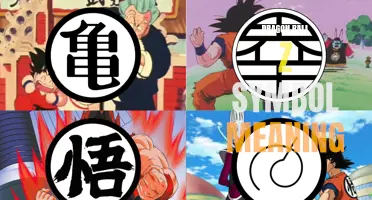
The harp, with its enchanting sound and ancient origins, has long been associated with deep symbolism and meaning. From ancient mythology to modern music, the harp has held a special place in various cultures, representing everything from love and beauty to transcendence and divine inspiration. Its elegant design and delicate strings have become a powerful symbol of harmony, peace, and the connection between earth and heaven. In this article, we will explore the rich and fascinating symbolism behind the harp, uncovering the layers of meaning that make it such a captivating and meaningful instrument.
What You'll Learn
- What does the harp symbol traditionally represent in Celtic culture?
- How has the meaning of the harp symbol evolved over time?
- Are there any cultural or religious meanings associated with the harp symbol?
- What is the significance of the harp symbol in heraldry?
- How does the harp symbol differ in meaning across different cultures or regions?

What does the harp symbol traditionally represent in Celtic culture?
The harp is a significant symbol in Celtic culture and holds great importance in their folklore, mythology, and history. Traditionally, the harp symbolizes various aspects of Celtic life, including music, culture, spirituality, and national identity.
In Celtic mythology, the harp is associated with the god Dagda, one of the most important deities in the Celtic pantheon. Dagda was said to possess a magical harp known as the "Uaithne," which had the power to control the seasons and bring peace and harmony. The harp of Dagda represents the harmonious balance between the physical and spiritual realms.
In Celtic folklore, the harp is often depicted as a source of enchantment and inspiration. It is believed that the music played on the harp has the ability to heal wounds, calm the mind, and uplift the spirit. The harp is often associated with bards and druids, who were revered for their wisdom, poetic skills, and connection to the divine.
The harp also holds a significant role in Irish history and national identity. It is the official emblem of Ireland and is found on various national symbols such as coins, official documents, and the presidential seal. The harp has been used as a symbol of Irish resistance against British colonization, with many Irish patriots and rebels incorporating it into their flags and banners.
Throughout Celtic culture, the harp is not only a musical instrument but also a symbol of cultural heritage and pride. It embodies the spirit of the Celts, their love for music, and their deep connection to their land and traditions. The beauty and complexity of the harp's music reflect the profound wisdom and creativity of the Celtic people.
In conclusion, the harp symbolizes music, culture, spirituality, and national identity in Celtic tradition. It is a powerful emblem that represents the harmonious balance between the physical and spiritual realms, inspires enchantment and creativity, and holds great significance in Celtic mythology, folklore, and history. The harp continues to be a cherished symbol of Celtic heritage, connecting the past with the present and reminding us of the enduring spirit of the Celts.
The Symbolic Meaning of Bird Poop in Islam: A Sign of Blessings or Misfortune?
You may want to see also

How has the meaning of the harp symbol evolved over time?
The harp is an ancient musical instrument that has been a symbol of various cultural and historical significance throughout the ages. Its meaning and symbolism have evolved over time, reflecting the changing beliefs, values, and customs of different societies.
In ancient times, the harp was often associated with divine beings and considered a sacred instrument. In ancient Egypt, for example, the harp was believed to be the instrument of choice for the gods. It was often depicted in the hands of deities such as Osiris and Hathor, symbolizing their power and divine status.
In Greek mythology, Apollo, the god of music, was often depicted holding a golden harp. The instrument was believed to possess magical powers and was associated with the harmony and order of the cosmos.
During the medieval period, the harp became closely associated with the courtly aristocracy in Europe. It was often played by minstrels and troubadours who entertained the nobility with their musical skills. The harp was seen as a symbol of refinement, elegance, and high social status.
In Celtic folklore and mythology, the harp held deep symbolic meaning. It was often associated with the spirits of nature and the Otherworld. The harp was believed to have the power to unite the earthly and spiritual realms and was often played during religious ceremonies and rituals.
In Irish mythology, the harp was particularly revered and associated with the legendary figure of Dagda, the god of the earth and abundance. It was said that Dagda's harp had the ability to control the seasons and bring about peace and harmony.
During the Renaissance period, the harp became a popular instrument among the nobility and was often depicted in portraits of the wealthy and powerful. It continued to symbolize refinement and high social status.
In more recent times, the harp has come to be associated with Ireland and its cultural heritage. It is the national symbol of Ireland and appears on the country's official coat of arms. The harp is also the emblem of Guinness, the famous Irish brewery, further solidifying its association with Irish culture.
Today, the harp continues to be a symbol of beauty, elegance, and musicality. It is often featured in logos, trademarks, and emblems, representing various organizations and institutions related to music, arts, and culture.
In conclusion, the meaning of the harp symbol has evolved over time, reflecting the beliefs and values of different societies. From its association with divine beings in ancient times to its role as a symbol of social status and cultural heritage, the harp continues to captivate and inspire people around the world.
Understanding the Meaning of the Car with Lock Symbol on the Dashboard
You may want to see also

Are there any cultural or religious meanings associated with the harp symbol?
The harp has been a significant symbol in various cultural and religious contexts throughout history. Its association with music and its resonance are often seen as representative of harmony, spirituality, and divine communication. Let's explore some of the cultural and religious meanings associated with the harp symbol.
In Celtic and Irish mythology, the harp holds great importance. It is often linked to the gods and served as a medium of communication between the mortal and divine realms. The harp's soothing melodies were believed to bring joy, healing, and harmony to the listeners. In Irish folklore, the harp is also associated with the bards and the power of storytelling.
In Christianity, the harp is often associated with King David. According to biblical accounts, David was not only a skilled harpist but also used the instrument to worship and praise God. The book of Psalms, which is said to have been written by David, refers to the harp multiple times as an instrument of worship and a means of expressing deep emotions and devotion.
In some African cultures, the harp symbolizes spirituality and divine intervention. For example, the kora, a West African harp-lute instrument, is believed to connect the musician with the spirits and ancestors. It is often used in spiritual ceremonies and rituals to invoke blessings and communicate with the supernatural.
Furthermore, the harp is a prominent symbol in the coat of arms of Ireland. The Irish harp is one of the oldest national symbols in the world and represents national identity, heritage, and cultural pride. It is often depicted as a golden harp with silver strings, resembling the instrument's historical significance and its association with traditional Irish music.
Apart from its cultural and religious meanings, the harp symbol is also commonly associated with music, creativity, and artistic expression. Its elegant design and captivating sound have made it a popular choice for various musical genres, including classical, folk, and contemporary music.
Whether viewed as a representation of divinity, a connection to one's cultural roots, or a symbol of artistic expression, the harp holds a significant place in various cultures and religions. Its rich history and associations continue to add depth and meaning to this timeless instrument.
A Guide to Understanding GMC Dashboard Symbols and Their Meanings
You may want to see also

What is the significance of the harp symbol in heraldry?
The harp is a musical instrument that has been used for centuries and is often associated with Ireland. In addition to its musical significance, the harp is also a common symbol in heraldry, which is the system of symbols used to identify and distinguish individuals, families, or organizations.
In heraldry, the harp is typically depicted as a stringed instrument with a concave-shaped soundbox and a series of strings. The number of strings can vary, but it is usually represented with 10 strings. The harp is often shown in a vertical position, with the strings facing upwards and the soundbox at the bottom. Sometimes, the harp is also depicted with a crown on top, indicating nobility or royalty.
The harp symbol in heraldry has a rich history that dates back to ancient times. It is believed to have originated in Egypt, where it was an instrument associated with the divine and was often used in religious rituals. The harp symbol was later adopted by the Celts and became an important symbol in their culture. The Celts saw the harp as a sacred instrument that had the power to heal, inspire, and bring joy.
In heraldry, the harp symbolizes a variety of qualities and characteristics. It is associated with music, art, creativity, and culture. The harp also represents harmony, unity, and balance. It is a symbol of peace and tranquility, as well as grace and beauty. Additionally, the harp is often associated with myths and legends, and it is seen as a symbol of the supernatural and the mystical.
The harp is particularly significant in Irish heraldry, as it is the national symbol of Ireland. The harp has been used as a symbol of Ireland for centuries and is seen on the country's coat of arms and official flag. The harp is also associated with Irish identity and culture, and it is often used to represent Irish heritage and pride.
In conclusion, the harp is a significant symbol in heraldry that represents music, art, and culture. It is associated with harmony, unity, and peace, and it is often seen as a symbol of beauty and grace. In Irish heraldry, the harp is particularly significant and is the national symbol of Ireland. The harp has a rich history and carries with it a sense of tradition, heritage, and identity.
Understanding the Symbols and Meanings on Yamaha Tach Gauges
You may want to see also

How does the harp symbol differ in meaning across different cultures or regions?
The harp is a musical instrument that has been used for centuries in various cultures and regions around the world. It is known for its unique sound and beautiful design. However, the harp is not just a musical instrument; it also holds symbolic meaning in different cultures.
In Western culture, the harp is often associated with elegance, grace, and peace. It is a common symbol in classical music and is often used to represent angelic or spiritual beings. In ancient Greece, the harp was believed to be a magical instrument that could heal and soothe the soul. Greek gods and goddesses, such as Apollo and Orpheus, were often depicted playing the harp.
In Celtic culture, the harp holds great significance and is considered a national symbol for countries like Ireland and Scotland. The Celtic harp, also known as the cláirseach, is a traditional instrument that has been played for centuries. It represents national identity, culture, and tradition. The harp can be seen on the coat of arms of Ireland and is also used as a logo for various Irish and Scottish organizations.
In ancient Egypt, the harp was associated with the goddess Hathor, who was often depicted playing the instrument. Hathor was a goddess of love, beauty, and joy, and the harp symbolized these qualities. The harp was also used in religious ceremonies and was believed to have the power to invoke the gods.
In some African cultures, the harp is played during important rituals and ceremonies. It is believed to connect the spiritual world with the physical world and is used as a tool for communication with ancestors and spirits. The harp is often adorned with symbolic elements, such as feathers or shells, to enhance its spiritual significance.
In conclusion, the harp symbol differs in meaning across different cultures and regions. In Western culture, it represents elegance and spirituality. In Celtic culture, it is a national symbol that represents tradition and heritage. In ancient Egypt, it is associated with the goddess of love and joy. In African cultures, it is used for spiritual communication and connection with ancestors. The harp's symbolic meaning reflects the unique cultural perspectives and beliefs of each region.
Exploring the Mystical Meanings of Tibetan Singing Bowl Symbols
You may want to see also
Frequently asked questions
The harp symbol is often associated with music and represents the power and beauty of music. In many cultures, the harp symbolizes harmony, love, and joy. It is also seen as a symbol of peace and divine inspiration. Additionally, the harp symbol is often used to honor and remember musicians and artists.
Yes, the harp symbol has different meanings in various cultures and religions. In Irish culture, the harp is a national symbol and represents national pride and identity. In ancient Greek mythology, the harp is associated with Apollo, the god of music, and is seen as a symbol of divine creativity and inspiration. In Christianity, the harp is often depicted in religious artwork and is associated with heavenly praise and worship.
In Celtic mythology, the harp is a powerful and magical instrument. It is said to have the ability to bring forth healing, transformation, and spiritual awakening. The harp is often associated with the Celtic god Dagda, who was known as the "good god" and was revered for his wisdom and mastery of music. In Celtic tradition, the harp symbolizes the power of music to connect with the spiritual realm and bring balance and harmony to the world.
In modern society, the harp symbol is often used to represent music and the arts. It can be found on musical instruments, music logos, and album covers. The harp symbol is also commonly used to represent Ireland and its culture, as well as being a symbol of peace and harmony. In addition, the harp symbol is often used in memorializing musicians and artists who have passed away, serving as a tribute to their contributions to the world of music and the arts.







